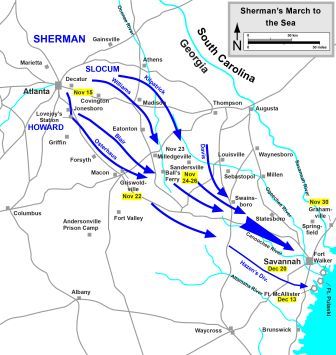 |
| http://www.wired.com/thisdayintech/2010/11/1115-sherman-march-to-sea/ |
The Atlanta campaign was the first out of 2 campaigns that
union general William t. Sherman commanded. His principle was to gain and
occupy Atlanta, due to Atlanta’s role as a major railroad hub of the south and
its industrial capabilities, in which would cause a significant loss for the
confederacy. Confederate general Joseph Johnston army was outnumbered 2 to 1 by
the union’s army. He then decided to use defensive tactics against Sherman to
at the very least try to slow down union soldiers. This defensive work ethic
was utilized as a distraction. Similarly, when you’re hiding something from
your parents, you do or say things to distract them. While Johnston hoped to
lure Sherman into costly head on attacks, Sherman would simply go around, or
out flank, the CSA’s position. He then continued to advance to what he really
wanted, Atlanta. By the time general Johnston would realize this, it would be
too late to attack on the union soldiers to they would have to withdrawal from
their defensive strongholds. Because he repeatedly had to withdrawal, allowing Sherman
and his men to get closer and closer to Atlanta untouched, he was replaced by a
more aggressive general, confederate general john b. hood. Hood was instructed
to take on Sherman’s army head on and protect the city of Atlanta, and he did
so as commanded. Even thought he put in his best effort to halt and stall the
union soldiers, he was unsuccessful, allowing Sherman to get close enough to Atlanta
to begin to bombard it with cannon fire. On September 2, 1864, General Hood was
forced to withdraw from Atlanta leaving the city open for Union occupation.
Sherman held the city for more than two months planning for what was to be
called The March to the Sea. On Nov 15, 1864, Sherman’s army left Atlanta. He left
Atlanta burning, ruining everything in his path. from
 |
http://www.britannica.com/EBchecked/media/8620/Fires-blaze-while-Union-soldiers-destroy-railroad-tracks-in-Atlanta
from November 15 until December 21, 1864, Union General William T. Sherman led some 60,000 soldiers on a 285-mile march from Atlanta to Savannah, Georgia. The purpose of this “March to the Sea” was to frighten Georgia’s civilian population into abandoning the Confederate cause. After conquering Atlanta, Sherman set his mind on the rest of Georgia, and the punishment they deserved for being responsible for starting this war and these were to be the consequences they were to face. From November 15 until December 21, 1864, Union General William T. Sherman led some 60,000 soldiers on a 300-mile long and 60 miles wide march from Atlanta to Savannah, Georgia. Throughout this time, Hood attempted to once again, lure Sherman in their direction towards Tennessee, leaving Sherman and his men a clear, smooth path to savannah. Sherman’s men were instructed to liberally forage on the county during the march. They were also instructed to not disturb citizen unless they resisted and fought back, then they were allowed to set their houses and crops on fire. There were only two battles during Sherman’s March to Sea and the battle of Griswoldville was the most tragic. Sherman’s battle-hardened army was attacked by a force of Georgia militia made up of men too old and boys too young to fight in the regular army. In this battle over 650 of the Georgians were killed in comparison to 62 Union soldiers. With no confederates to fight off any longer, they arrived in savannah Georgia December 22, 1864. When they arrived at savannah, they not wanting to be bombarded just like griswoldville was, surrendered to the union almost immediately. He then sent Abraham the good news in a telegram enunciating, “I beg to present you as a Christmas gift the city of Savannah. . . .” This win was imperative for Lincoln to be reelected in 1864.

http://www.ducksters.com/history/shermans_march_to_the_sea.php
video of shermans march to sea: http://www.history.com/topics/shermans-march/interactives/shermans-march
shermans field orders: http://www.sewanee.edu/faculty/Willis/Civil_War/documents/Sherman120.html
|



No comments:
Post a Comment